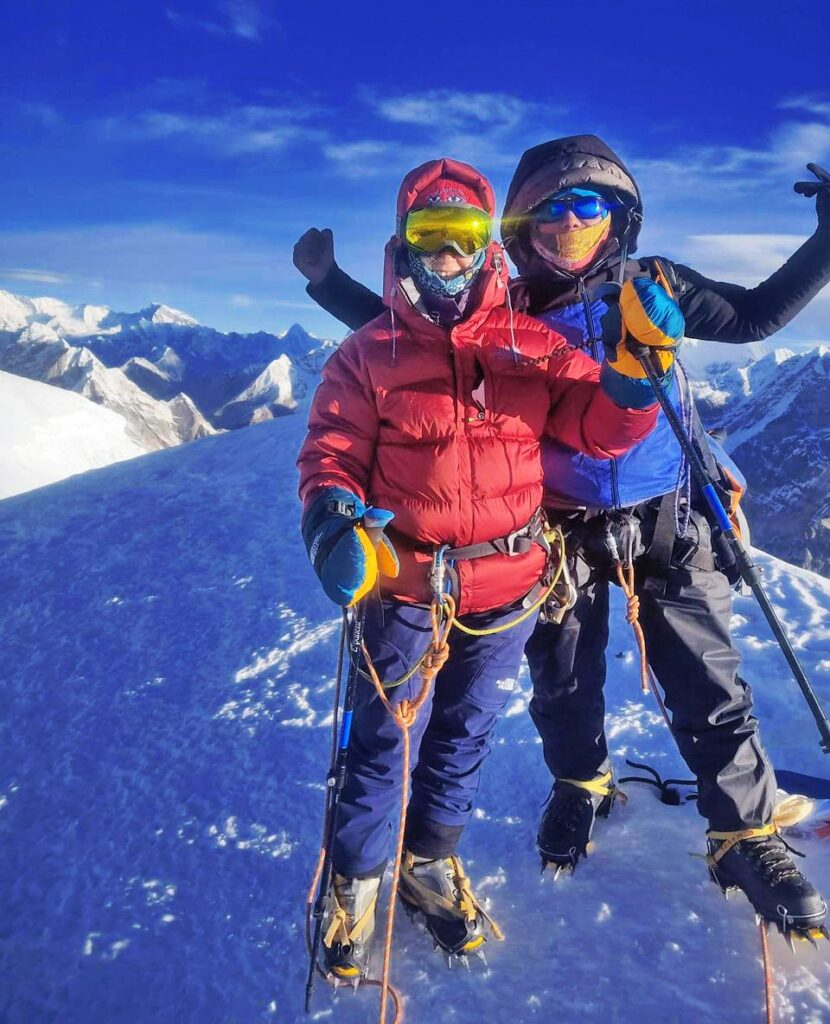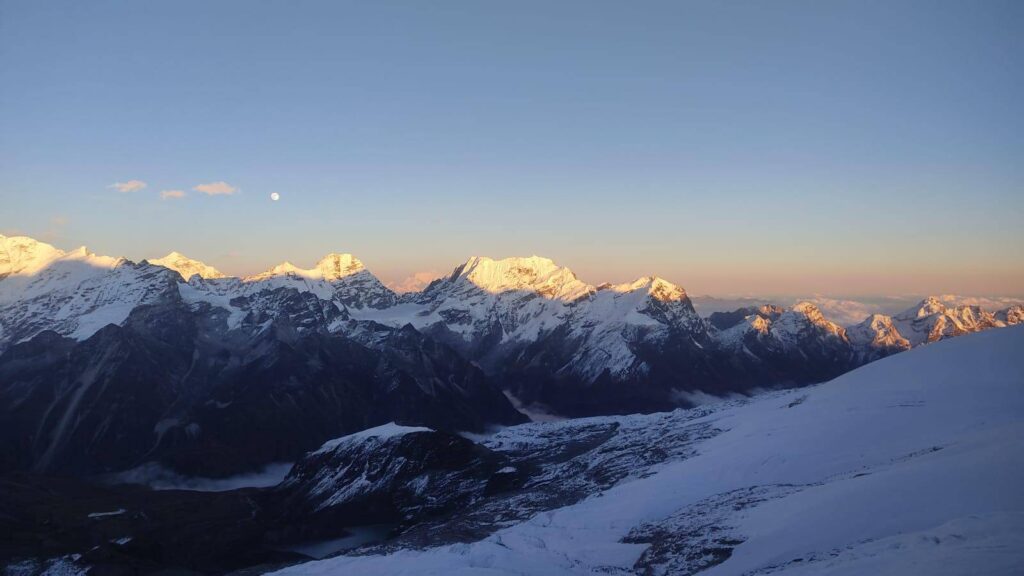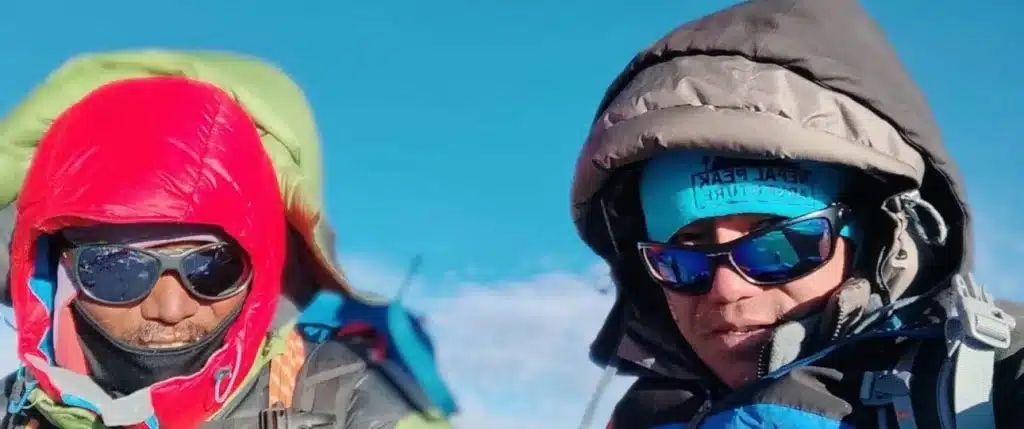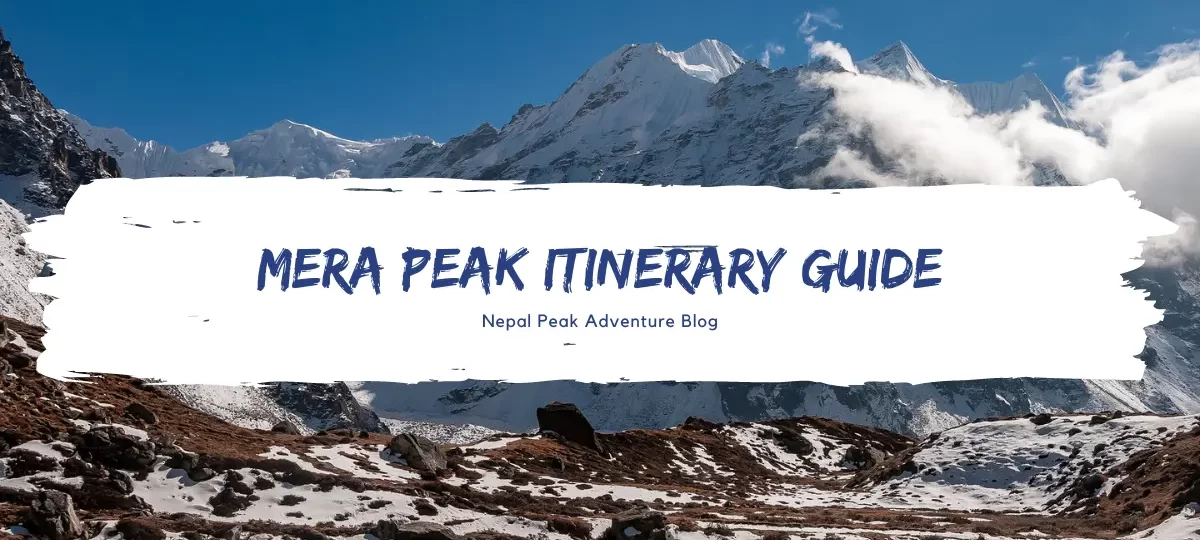Mera Peak Itinerary Guide: 14,17,18, and 21 Days
Welcome to another blog of Nepal Peak Adventure where you will learn about the Mera Peak Itinerary, multiple choices for Mera Peak, the Importance of choosing the right itinerary, expert tips, & many more.
“Let’s get started”
Table of Contents
Introduction to Mera Peak Climbing

Rising to an awe-inspiring elevation of 6,476 meters (21,246 feet), Mera Peak is renowned as Nepal’s highest trekking point, promising a once-in-a-lifetime experience for those seeking the ultimate Himalayan summit.
With its strategic location on the edge of the Khumbu region, this towering peak opens up a breathtaking panorama of five of the world’s highest peaks, including the mighty Everest, Lhotse, Cho Oyu, Makalu, and Kanchenjunga.
The allure of Mera Peak lies not only in its lofty stature but also in its accessibility to both seasoned climbers and novice trekkers, making it an achievable dream for adventure lovers from all walks of life.
Unlike some of the more technical and challenging peaks, Mera Peak boasts a relatively straightforward ascent that does not demand prior mountaineering experience or specialized technical skills. This makes it an ideal choice for passionate trekkers who dare to venture into the realm of mountaineering without overwhelming complexities.
Moreover, the journey to the summit of Mera Peak is a mesmerizing odyssey through enchanting villages, lush rhododendron forests, and elusive wildlife sightings high up in the Himalayas.
As you traverse remote valleys, cross high passes, and navigate icy glaciers, the allure of the uncharted Himalayan wilderness unfurls before your eyes.
Importance of well-planned itineraries for a successful climb
A successful ascent to Mera Peak’s majestic summit lies not only in the determination of the climber but also in the meticulous planning of a well-crafted itinerary. An expertly designed itinerary ensures proper acclimatization and gradual altitude gain, significantly reducing the risks of altitude sickness and ensuring a safe and rewarding climb.
As professional climbing guides, we prioritize the safety and satisfaction of our adventurers. Our carefully tailored itineraries take into account strategic acclimatization and rest days at crucial points along the journey, allowing climbers to adapt to higher altitudes and optimize their chances of reaching the peak.
Understanding the Different Itinerary Options
When embarking on the remarkable journey to conquer Mera Peak, choosing the right itinerary is crucial for a successful and gratifying climb. Each itinerary offers a unique blend of adventure, acclimatization, and awe-inspiring landscapes, catering to varying levels of experience and time constraints.
As your trusted climbing guide, we present a range of meticulously crafted itinerary options, each designed to optimize your chances of summiting the majestic Mera Peak while relishing the beauty of the Himalayas.
12 Days Mera Peak Climbing Itinerary: A Quick Yet Adventurous Ascent
Ideal for adventurers seeking a shorter but no less exhilarating climb, the 12-day itinerary provides a swift and efficient route to the Mera Peak summit.
This itinerary prioritizes crucial acclimatization periods, allowing climbers to adapt to higher altitudes effectively. While the ascent is faster, rest assured that safety remains paramount, with our experienced guides providing constant support.
Who are suitable for 12 Days Mera Peak Climbing?
This 12 Days Mera Peak Climb option is suitable for those with prior trekking or mountaineering experience and a desire to experience the thrill of standing atop the Mera Peak summit in a relatively shorter time frame.
Difficulty level for 12 Days Itinerary:
As this itinerary is designed for trekkers with good fitness levels, 12 Days Mera Peak itinerary is a challenging level adventure in terms of difficulty. The trek to Mera Peak Base Camp involves long days of walking through varied terrain, including some steep ascents and descents.
12 Days Mera Peak Outline Itinerary
- Day 1: Fly from Kathmandu to Lukla, then trek to Chutanga.
- Day 2: Trek from Chutanga to Thuli Kharka/Chatra-La (3,900 m) via Zwatra-La Pass.
- Day 3: Trek from Thuli Kharka to Kothe.
- Day 4: Trek from Kothe to Thaknak.
- Day 5: Trek from Thaknak to Khare.
- Day 6: Acclimatization at Khare.
- Day 7: Trek from Khare to High Camp.
- Day 8: Summit day – Climbing from High Camp to the Peak (6,461 m), then back to Khare.
- Day 9: Trek from Khare to Kothe.
- Day 10: Trek from Kothé to Thuli Kharka/Chatra-la.
- Day 11: Trek from Thuli Kharka to Lukla, approximately 7/8 hours walk.
- Day 12: Fly back to Kathmandu from Lukla.
14 Days Mera Peak Climbing Itinerary: Balancing Time and Acclimatization
The 14-day itinerary offers a balanced blend of thrill and tranquility, providing ample time for acclimatization and immersing in the breathtaking landscapes of the Khumbu region.
This itinerary allows climbers to fully appreciate the unique culture and natural wonders of the Himalayas, with leisurely treks through picturesque villages and lush forests.
Who are suitable for 14 Days Mera Peak Climbing?
It is an excellent choice for those who wish to savor the journey to the summit while building endurance and adjusting to the altitude, making the overall experience more rewarding and fulfilling.
Difficulty level of 14 Days Mera Peak Climbing:
With a slightly longer duration than the 12-day option, this 14 Days itinerary offers a balanced blend of trekking challenges and a more technical climb.
14 Days Mera Peak Outline Itinerary:
- Day 1: Arrival in Kathmandu (1,400m/4,593ft) – Transfer to Hotel and Trek Preparation
- Day 2: Fly to Lukla and trek to Chutanga (3,100m/10,168ft) – 35 minutes flight and 4 to 5 hours trek
- Day 3: Trek from Chutanga to Thuli Kharka (4,300m/14,104ft) via Zatrwa La (4,600m/15,092ft) – 5 to 6 hours trek
- Day 4: Trek from Thuli Kharka to Kothe (3,691m/12,107ft) – 6 to 7 hours trek
- Day 5: Trek from Kothe to Thaknak (4,358m/14,295ft) – 3 to 4 hours trek
- Day 6: Trek from Thaknak to Khare (5,045m/16,548ft) – 3 to 4 hours trek
- Day 7: At Khare – Acclimatization Day and pre-climb training
- Day 8: Trek from Khare to Mera High Camp (5,780m/18,958ft) – 5 to 6 hours trek
- Day 9: Summit Mera Peak (6,461m/21,193ft) and trek to Khare (5,045m/16,548ft) – 11 to 12 hours trek/climbing
- Day 10: Contingency Day for Mera Peak Summit
- Day 11: Trek from Khare to Kothe to Thuli Kharka (4,300m/14,104ft) – 8 to 9 hours trek
- Day 12: Trek to Lukla (2,840m/9,316ft) via Zatrwa La Pass (4,600m/15,088ft) – 5 to 6 hours trek
- Day 13: Fly from Lukla to Kathmandu (1,400m/4,593ft) – 35 minutes flight
- Day 14: Depart Kathmandu
17 Days Mera Peak Climbing Itinerary: Embracing the Himalayan Experience
For adventure enthusiasts seeking a more immersive and comprehensive expedition, the 17-day itinerary is the ultimate choice. This option encompasses an extended trekking journey through the Khumbu region, offering a deeper understanding of local culture and a chance to witness iconic landmarks like the legendary Everest Base Camp.
The additional time ensures optimal acclimatization, making it suitable for both experienced climbers and those new to high-altitude adventures. This itinerary allows you to create unforgettable memories and forge lasting connections with the awe-inspiring Himalayas.
Difficulty level of 17 Days Mera Peak Climbing
With the addition of the Amphu Labtsa Pass, climbers get the chance to explore a less-traveled and remote region of the Everest region, providing a sense of discovery and uniqueness.
Crossing the Amphu Labtsa Pass (5,780m) involves technical climbing and the use of ropes, providing a thrilling mountaineering experience beyond the summit of Mera Peak.
17 Days Mera Peak Outline Itinerary:
- Day 1: Arrival at Kathmandu Airport, Transfer to the hotel (1350M/4,430ft)
- Day 2: Trek Preparation & Exploration Day in Kathmandu.
- Day 3: Flight from Kathmandu to Lukla (2800m) & trek to Chutanga (3050m) which take about 4 hours.
- Day 4: Trek from Chutanga to Tuli Kharka (Chatra-La) (3900m) which takes about 6 hours. You trek via Zatrawa La Pass (4610m) and downclimb to Khartitang at 3900m.
- Day 5: Trek from Tuli Kharka to Kothe (4095m) – 5hrs.
- Day 6: Trek from Kothe to Tangnang (4,350m) – 5hrs. Enjoy the fantastic view of the south face of Mera Peak throughout the day
- Day 7: Rest and acclimatization day at Thangnak. Visit Sabal Tsho Lake and take an acclimatization hike to the cairn (5271m) on the flank of Kusum Kangguru (6367m).
- Day 8: Trek from Tangnang to Khare (5,045m) – takes about three and a half hours.
- Day 9: Trek and climb from Khare to high camp (5,780m) – 4-5hrs.
- Day 10: Summit Day; Mera High Camp to Summit (6,654m) and return to Khare.
- Day 11: One spare day in case of bad weather during the summit day.
- Day 12: Trek from Khare to Kothe (3600m) – 5hrs.
- Day 13: Trek from Kothe to Thuli Kharka – takes about six hours.
- Day 14: Thuli Kharka to Lukla: via Zatrwa La pass. This is the last evening in the mountains, the ideal opportunity for a farewell party with our staff.
- Day 15: Early in the morning, fly from Lukla to Kathmandu, which takes about 35 minutes. Transfer to hotel. Leisure and shopping day in Kathmandu.
- Day 16: Explore and shop in Kathmandu. Farewell-Celebration dinner with cultural programming in the evening.
- Day 17: Transfer to the airport for the final departure
18 Days Mera Peak Climbing Itinerary: Immersive Cultural and Himalayan Experience
The 18-day itinerary offers the complete Mera Peak adventure, encompassing the splendor of the 17-day option with an additional day for potential contingencies due to weather or any other unforeseen circumstances.
This comprehensive journey ensures a seamless and stress-free climb, providing ample time for proper acclimatization and multiple opportunities to soak in the breathtaking vistas.
Who are suitable for 18 Days Mera Peak Climbing?
It is the perfect choice for climbers who value flexibility and desire to maximize their chances of conquering the majestic Mera Peak while embracing every moment of the expedition.
18 Days Mera Peak Outline Itinerary
- Day 01: Arrival in Kathmandu Airport & Transfer to Your Hotel(1400m)
- Day 02: Sightseeing inside Kathmandu Valley & Preparing for the trek & climb (1400m)
- Day 03: Flight from Kathmandu/Ramechhap to Lukla (2860m) and trek to Paiya/Puiya (2730m)
- Day 04: Paiya/Puiya to Panggom Trek (2846m)
- Day 05: Trek to Ningsow (2863m)
- Day 06: Trek to Chhatra Khola (2800m)
- Day 07: Trek to Kothe (3691m)
- Day 08: Trek to Thagnak (4358m)
- Day 09: Trek to Khare (5045m)
- Day 10: Acclimatization and pre-climbing training
- Day 11: Trek to Mera High Camp (5780m)
- Day 12: Climb to Summit (6461m) and return to Khare (5045m)
- Day 13: Reserve Day for Contingency
- Day 14: Trek to Kothe (3600m)
- Day 15: Trek to Thuli Kharka (4300 m)
- Day 16: Trek to Lukla (2642m)
- Day 17: Fly back to Kathmandu (1400m)
- Day 18: Departure from Kathmandu
21 Days Mera Peak Climbing Itinerary: The Ultimate Himalayan Adventure
For those seeking the ultimate Himalayan odyssey, the 21-day Mera Peak climbing itinerary is an unrivaled adventure.
This extended expedition allows for a truly immersive experience, offering ample time for acclimatization and exploration of the Khumbu region’s hidden gems.
Difficulty level of 21 Days Mera Peak Climbing:
The 21 Days Mera Peak Climbing itinerary is considered to be of moderate to challenging difficulty level. The itinerary allows for gradual acclimatization, reducing the risk of altitude sickness and enhancing the chances of reaching the summit successfully.
21 Days Mera Peak Outline Itinerary:
- Day 01: Arrive in Kathmandu, transfer to hotel
- Day 02: Rest day in Kathmandu
- Day 03: Kathmandu to Paphlu by road – 8 hrs
- Day 04: Paphlu to Nunthala
- Day 05: Nunthala to Bupsa
- Day 06: Bupsa to Pangkoma
- Day 07: Pangkoma to Ningso
- Day 08: Ningso to Chetra Khola
- Day 09: Chetra Khola to Khote
- Day 10: Khote – Tangnag
- Day 11: Tangnag – Khare
- Day 12: Khare rest day
- Day 13: Khare – Mera La (5413m) then Mera BC
- Day 14: Mera High Camp
- Day 15: To Mera Peak (6476m)
- Day 16: Additional summit day
- Day 17: Khare to Khote
- Day 18: Khote – Tulli Kharka – Zetra La (4610m) – Chuthanka
- Day 19: Chuthanka – Lukla
- Day 20: Lukla – Kathmandu by air and back to the hotel.
- Day 21: Flight out of Kathmandu
Factors to Consider When Choosing an Itinerary

When embarking on the exhilarating journey of Mera Peak climbing, selecting the right itinerary is paramount to ensure a safe, enjoyable, and successful adventure.
As you plan for this once-in-a-lifetime expedition, several crucial factors should be taken into account to tailor an itinerary that aligns perfectly with your capabilities, preferences, and time constraints. Here are essential considerations to keep in mind when choosing your Mera Peak itinerary:
A. Physical Fitness and Climbing Experience
Mera Peak, while not as technically demanding as some other peaks, requires a certain level of physical fitness and endurance. Climbers should be prepared for long days of trekking, ascending and descending ridges, and facing high-altitude challenges.
Prior climbing experience is advantageous but not mandatory, as our expert Sherpa guides will provide essential training and support. However, having a basic understanding of peak climbing and being in good physical shape significantly enhances your chances of summiting Mera Peak successfully.
Regular cardiovascular workouts, strength training, and endurance exercises can help build the necessary stamina and mental resilience required for this challenging endeavor.
B.Time Availability and Travel Constraints
The duration of your Mera Peak expedition can vary based on the chosen itinerary and your available time. It is essential to consider the number of days you can dedicate to this adventure, including travel to and from Nepal.
Typical itineraries for Mera Peak climbing range from 12 to 21 days, depending on factors like acclimatization days, rest periods, and weather conditions. If you have time constraints, opt for a shorter itinerary with fewer rest days, but ensure that it still allows adequate acclimatization to avoid altitude-related risks.
Conversely, if you have more time to spare, a longer itinerary will provide a more relaxed pace, offering better chances of adapting to the high altitude and achieving the summit.
C. Weather and Best Climbing Seasons
The weather and climatic conditions play a vital role in determining the success of your Mera Peak expedition. Nepal experiences distinct trekking seasons, each offering its own set of advantages and challenges.
The two primary climbing seasons for Mera Peak are spring (March to May) and autumn (September to November). During these seasons, the weather is relatively stable, with clear skies and favorable temperatures, making the climbing experience more enjoyable and the views breathtaking.
However, it is crucial to be mindful of potential crowds during peak trekking seasons. For those seeking a quieter and less crowded experience, consider the pre-monsoon or post-monsoon seasons. While the monsoon season (June to August) is less favorable for climbing due to heavy rainfall, the winter season (December to February) brings colder temperatures and potentially challenging snow conditions.
Expert Tips for a Successful Mera Peak Expedition

Embarking on a Mera Peak climbing expedition is a thrilling adventure that requires meticulous planning and preparation.
To ensure a safe and successful journey to the Himalayan summit, here are some expert tips that will guide you through the challenges and help you make the most of your Mera Peak itinerary:
A. Proper Acclimatization and Altitude Adjustment
Acclimatization is the key to conquering high altitudes safely and avoiding altitude sickness. Your Mera Peak itinerary should include gradual ascents with ample rest days to allow your body to adjust to the thinning air.
Climbing higher and sleeping lower, a well-known mountaineering adage is essential to aid in acclimatization. Expertly crafted itineraries will have built-in acclimatization days at strategic points to ensure that your body adapts to the increasing altitude effectively. Listen to your body and communicate any discomfort or symptoms of altitude sickness to your guides promptly.
B. Essential Gear and Equipment Checklist
Climbing Mera Peak demands the right gear and equipment to withstand challenging conditions at higher elevations. Your itinerary should provide you with a comprehensive gear checklist, including items such as proper mountaineering boots, crampons, ice axes, harnesses, helmets, and clothing suited for extreme weather.
Ensure that you have high-quality, well-fitted gear that will keep you warm, dry, and comfortable during the climb. Don’t forget to pack essentials like a headlamp, water bottles, sleeping bags, and a first-aid kit. Double-checking your gear before the climb is crucial to avoid any last-minute mishaps.
C. Training and Preparation Before the Climb
Preparation is the key to a successful climb. Engage in regular physical training to build strength, endurance, and cardiovascular fitness. Focus on activities that simulate the challenges you’ll face during the expedition, such as hiking, stair climbing, and weight training. Additionally, practice using your climbing gear, including an ice axe and crampons, to familiarize yourself with the equipment. Acquiring basic mountaineering skills will boost your confidence and enhance your overall climbing experience.
D. Working with Experienced Sherpa Guides
Experienced Sherpa guides are invaluable companions on your Mera Peak expedition. Their vast knowledge of the region, weather conditions, and climbing techniques ensures a safe and efficient climb.
Look for a trekking agency that provides well-trained and certified Sherpa climbing guides with a proven track record of successful summits. The guidance and support of these local experts will not only increase your chances of reaching the summit but also enrich your journey with cultural insights and captivating stories of the mountain
E. Safety Measures and Emergency Protocols
Safety should always be the top priority during a mountaineering expedition. Before setting off on your Mera Peak climb, ensure that your itinerary incorporates safety measures and emergency protocols.
Familiarize yourself with the communication systems and emergency procedures established by the trekking agency. Carry personal safety gear like a satellite phone and a GPS tracker to stay connected with the support team and for potential rescue operations. Regular health check-ups during the climb are also essential to monitor your well-being.
Frequently Asked Questions (FAQs)
Common Inquiries about Mera Peak Climbing
What is Mera Peak, and why is it popular in Nepal?
Mera Peak is a majestic Himalayan peak standing at an elevation of 6,476 meters (21,246 feet) and is renowned as the highest trekking peak in Nepal. Its popularity stems from the stunning panoramic views it offers, including five of the world’s highest peaks – Everest, Lhotse, Cho Oyu, Makalu, and Kanchenjunga.
How challenging is Mera Peak climbing?
Mera Peak climbing is considered moderately challenging, making it an achievable goal for both experienced climbers and enthusiastic trekkers. While prior mountaineering experience is not mandatory, participants must have a good level of physical fitness and be mentally prepared for the high-altitude conditions.
What is the best time to climb Mera Peak?
The optimal seasons for Mera Peak climbing are the pre-monsoon (spring) from March to May and the post-monsoon (autumn) from September to November. During these periods, the weather is stable, and the skies offer clear views of the surrounding mountains.
Information on Permits and Regulations
Permits for Mera Peak Climbing:
Climbers need a permit to climb Mera Peak, and the cost varies based on the season. Permits can be obtained for spring (March to May) and autumn (September to November) at different rates. Additionally, a garbage deposit is required, which is refundable upon bringing back all waste from the mountain.
Trekking Permits and National Park Fees:
In addition to Mera Peak climbing permits, trekkers also need to obtain permits for the Sagarmatha National Park and Makalu Barun National Park, as the trail passes through these protected areas. These permits contribute to the conservation and preservation of the region’s natural beauty.
Suggested Blogs For Mera Peak Climbing:
In conclusion, Mera Peak Itinerary is a guide that provides you with a thrilling endeavor that promises adventure enthusiasts an unparalleled experience in the heart of the Himalayas. Embrace the challenge, embrace the beauty, and embark on a once-in-a-lifetime adventure to conquer Mera Peak. Also, look for more informative blogs like this here.
Mera Peak Difficulty: “Factors that affect difficulty and Solution”
Packing List for climbing Mera Peak: “Checklist of gears”
Mera Peak Climbing Cost: “Cost for climbing Mera Peak”



